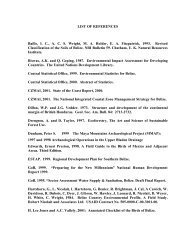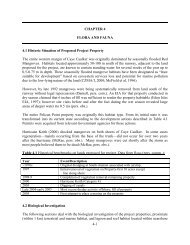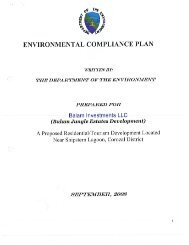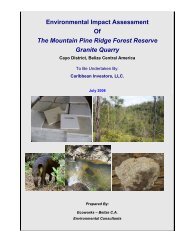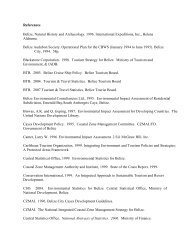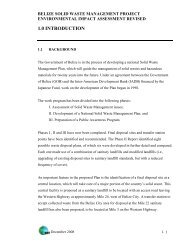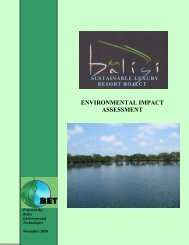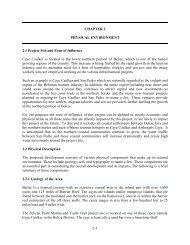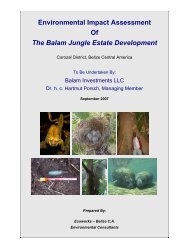Ambergris Caye Belize Resort Development - Department of ...
Ambergris Caye Belize Resort Development - Department of ...
Ambergris Caye Belize Resort Development - Department of ...
You also want an ePaper? Increase the reach of your titles
YUMPU automatically turns print PDFs into web optimized ePapers that Google loves.
2.2.6 Salinity<br />
The proposed project site is abutted on the eastern side by the open sea, and a lagoonal system<br />
referred to as the Laguna de Cantena on the western or leeward side [See PL 1.1 and Fig. 2.1].<br />
The seaward side <strong>of</strong> the property was characterized by oceanic quality water which ranged from<br />
29 ppt to 36 ppt, at the time <strong>of</strong> the Tunich Nah Survey, which took place between mid-April and<br />
mid-May 2006, [See Table 2.1]. The salinity <strong>of</strong> the waters <strong>of</strong>f the eastern shores <strong>of</strong> the property<br />
are expected to approximate oceanic quality throughout the year, with some slight elevations in<br />
value during the drier portions <strong>of</strong> the year [Pers. comm.., G. Myvett]: This is particularly relevant<br />
to the reef environment and the <strong>of</strong>fshore areas <strong>of</strong> the project site [See Sample Sites #’s 3, 4 & 5],<br />
given the proximity and contiguous articulation <strong>of</strong> the area with the pelagic deep ocean<br />
environment [See ‘I’ Fig. 2.1]. The average salinity in the area <strong>of</strong> the reef lagoon <strong>of</strong>f the eastern<br />
shores <strong>of</strong> the property has been stated as 37.2 ppt [BCES, 1993].<br />
The Laguna de Cantena is a fairly hyper saline body <strong>of</strong> water with limited connection with the<br />
moderating influences <strong>of</strong> the open sea environment, through various mangrove channels<br />
rereffred to as ‘Bogues’ [Pers. comm.., G. Myvett]. Salinity in the Lagoon ranged from 42 to 45<br />
ppt [See Sample Sites #’s 1 & 2 Table 2.1]. The stated average for salinity in the Laguna de<br />
Cantena was 40.9 ppt [BCES]. The hypersaline condition <strong>of</strong> the lagoon in the vicinity <strong>of</strong> the<br />
project site is understandable given the limited inflows <strong>of</strong> water from the wider marine<br />
environment [Pers. comm., G. Myvett].<br />
Apart from the open sea and the relatively expansive Laguna de Cantena, there are isolated<br />
hypersaline ponds and inundated depressions throughout the greater Bacalar Chico area with<br />
salinities as high as 123.8 ppt [Grimshaw and Paz, 2004]. None <strong>of</strong> these hypersaline ponds or<br />
inundated depressions was seen on the property during the Tunich Nah survey in April and May<br />
2006.<br />
Salinity is arguably among the most important physico-chemical parameters influencing the<br />
evolutionary history <strong>of</strong> the flora and fauna in the area: These biota are adapted to live in fairly<br />
high saline conditions and are not physiologically equipped to deal with any appreciable<br />
variation in salinities. The fauna adapted to live in these conditions have been characterized as<br />
being ‘stenohaline’ in character.<br />
2.2.7 Turbidity<br />
Visibility in the water column was approximately 250 ft. in the reef environment and 150 to 170<br />
ft. in the nearshore sea grass beds [Pers. comm., G. Myvett]. This was consistent with the<br />
Turbidity Values recorded in the area by the Tunich Survey Team: These values ranged from 2<br />
to 3 ppm on the 11 th May 2006, and from 1 to 2 ppm on the 16 th May 2006.<br />
The turbidity in the area varies with wave energy and currents: It generally increases with heavy<br />
sea states and strong tidal currents. Heavy sea states, in terms <strong>of</strong> annual cycles, are associated<br />
with the strong and sustained southeasterly winds in April and May, and the northerlies which<br />
affect the area from October to February [Pers. comm.., G. Myvett]. The stronger tidal currents<br />
2-8




